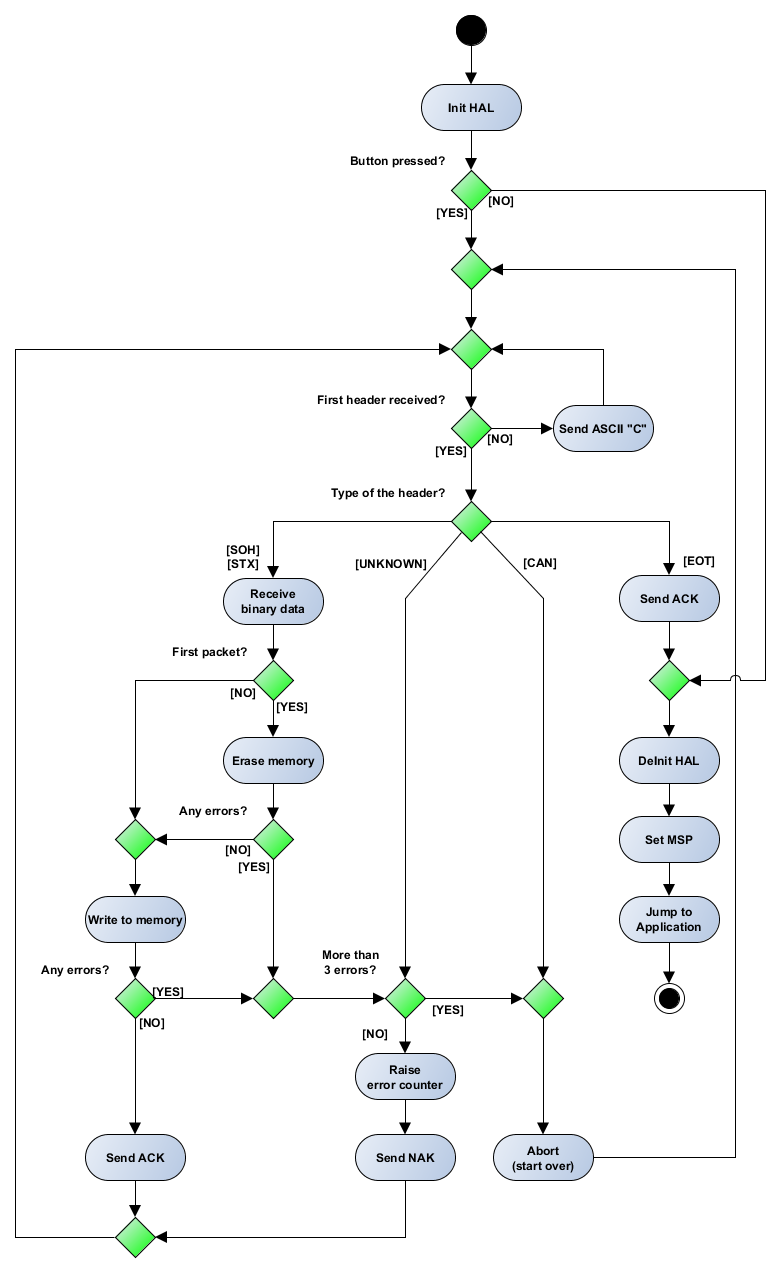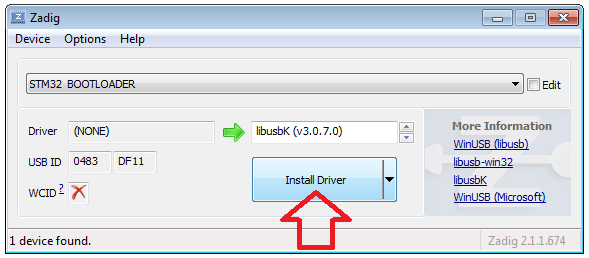Stm32 Bootloader Driver Windows 10 Rating: 6,6/10 9373 reviews If you ever have any issues when connecting your STM32 based flight controller to your PC, chances are you are using the wrong drivers for your board. STM32 'Blue Pill' Progmaming Via Arduino IDE & USB: Comparing STM32F generic prototype board (i.e. Blue Pill) to its counter part Arduino is easy to see how much more resources it has, which open a lot. Uploading STM32F103C8T6 USB Bootloader In order to upload the program via the USB Port on the Blue Pill, you need to have a USB Bootloader installed on the MCU. Thanks to the contributions of LeafLabs (Maple Bootloader) and rogerclarkmelbourne, a repo of bootloaders is available for a series of boards. To install drivers, navigate to C:Program Files (x86)ArduinohardwareArduinoSTM32-masterdriverswin where you will find installdrivers.bat and installSTMCOMdrivers.bat. After this step, your Arduino IDE is prepared to Program STM32 Blue Pill development board. Program Blue Pill STM32 directly with USB port Program STM32 directly with. Bootloader for STM32, XMC, HCS12 and other microcontroller targets. OpenBLT is mostly used as an STM32 bootloader, due to the popularity of STM32 microcontrollers. However, the bootloader's architecture is such that it can work with any microcontroller and use any type of communication interface to perform firmware updates.
Customizable Bootloader for STM32 microcontrollers. This project includes demonstrations for various hardware how to perform in-application-programming of a firmware located on external SD card with FAT32 file system.

Each example uses the same bootloader library located in the lib/stm32-bootloader folder. The examples are located in the projects folder and they come with a separate, dedicated README file with description related to that specific implementation.
Update: the STM32L496-Discovery example supports compiling and building the project with the GNU Arm Embedded Toolchain (ARM GCC) out-of-the-box, in addition to IAR EWARM. Check out the project README for further information.
Please refer to https://akospasztor.github.io/stm32-bootloader for complete documentation of the bootloader library source code.
Table of Contents
Bootloader features
- Configurable application space
- Flash erase
- Flash programming
- Flash verification after programming
- Checksum verification
- Flash protection check, write protection enable/disable
- Extended error handling, fail-safe design
- Bootloader firmware update and the ability to perform full chip re-programming: enter ST's built-in bootloader from software (without triggering the BOOT pin)
- Serial tracing over SWO for easier debugging and development
- Easy to customize and port to other microcontrollers
## Source code organization

The docs folder contains the generated documentation of the bootloader source code and other documentation-related static files.

The drivers folder contains the CMSIS (Cortex Microcontroller Software Interface Standard) as well as the HAL (Hardware Abstraction Layer) drivers from ST.
The bootloader source code and corresponding header file can be found in lib/stm32-bootloader folder. Additionally, the lib folder contains the FatFs library as well.
The various demonstrations reside in the projects folder. Each example project contains an include and source folder where the header and source files are located respectively. The compiler and SDK-specific files are located in their respective subfolders. Furthermore, every example project has a dedicated README file explaining its functionality in detail.
Examples
This repository contains the following examples.
| Microcontroller | Hardware | Project path |
|---|---|---|
| STM32L476VG | Custom | projects/STM32L476-CustomHw |
| STM32L496VG | Custom | projects/STM32L496-CustomHw |
| STM32L496AG | 32L496GDISCOVERY | projects/STM32L496-Discovery |

Each example uses the same bootloader library located in the lib/stm32-bootloader folder. The examples are located in the projects folder and they come with a separate, dedicated README file with description related to that specific implementation.
Update: the STM32L496-Discovery example supports compiling and building the project with the GNU Arm Embedded Toolchain (ARM GCC) out-of-the-box, in addition to IAR EWARM. Check out the project README for further information.
Please refer to https://akospasztor.github.io/stm32-bootloader for complete documentation of the bootloader library source code.
Table of Contents
Bootloader features
- Configurable application space
- Flash erase
- Flash programming
- Flash verification after programming
- Checksum verification
- Flash protection check, write protection enable/disable
- Extended error handling, fail-safe design
- Bootloader firmware update and the ability to perform full chip re-programming: enter ST's built-in bootloader from software (without triggering the BOOT pin)
- Serial tracing over SWO for easier debugging and development
- Easy to customize and port to other microcontrollers
## Source code organization
The docs folder contains the generated documentation of the bootloader source code and other documentation-related static files.
The drivers folder contains the CMSIS (Cortex Microcontroller Software Interface Standard) as well as the HAL (Hardware Abstraction Layer) drivers from ST.
The bootloader source code and corresponding header file can be found in lib/stm32-bootloader folder. Additionally, the lib folder contains the FatFs library as well.
The various demonstrations reside in the projects folder. Each example project contains an include and source folder where the header and source files are located respectively. The compiler and SDK-specific files are located in their respective subfolders. Furthermore, every example project has a dedicated README file explaining its functionality in detail.
Examples
This repository contains the following examples.
| Microcontroller | Hardware | Project path |
|---|---|---|
| STM32L476VG | Custom | projects/STM32L476-CustomHw |
| STM32L496VG | Custom | projects/STM32L496-CustomHw |
| STM32L496AG | 32L496GDISCOVERY | projects/STM32L496-Discovery |
How to use
The bootloader can be easily customized and tailored to the required hardware and environment, i.e. to perform firmware updates over various interfaces or even to implement over-the-air (OTA) updates if the hardware incorporates wireless communication modules. In order to perform successful in-application-programming, the following sequence has to be kept:
- Check for flash write protection and disable it if necessary.
- Initialize flash with
Bootloader_Init(). - Erase application space with
Bootloader_Erase(). - Prepare for programming by calling
Bootloader_FlashBegin(). - Perform programming by repeatedly calling the
Bootloader_FlashNext()function. The programming procedure requires 8 bytes of data (double word) to be programmed at once into the flash. This function automatically increases the address where the data is being written. - Finalize programming by calling
Bootloader_FlashEnd().
Stm32 Dfu Driver
The application image has to be in binary format. If the checksum verification is enabled, the binary must include the checksum value at the end of the image. When creating the application image, the checksum has to be calculated over the entire image (except the checksum area) with the following parameters:
- Algorithm: CRC32
- Size: 4 bytes
- Initial value: 0xFFFFFFFF
- Bit order: MSB first
Important notes:
- In order to perform a successful application jump from the bootloader, the vector table of the application firmware should be relocated. On system reset, the vector table is fixed at address 0x00000000. When creating an application, the microcontroller startup code sets the vector table offset to 0x0000 in the
system_stm32xxxx.cfile by default. This has to be either disabled (the bootloader can be configured to perform the vector table relocation before the jump) or manually set the vector table offset register (VTOR) to the appropriate offset value which is the start address of the application space. For more information, please refer to [1]. - The linker settings of the application firmware need to be adjusted from their default settings so that the start address of flash reflects the actual start address of the application space.
Configuration
The bootloader can be widely configured in the bootloader.h file. The file includes detailed comments and descriptions related to the configurable parameters and definitions.
Stm32 Driver Download
References
Stm Usb Vcp Drivers
[1] PM0214, 'STM32F3 Series, STM32F4 Series, STM32L4 Series and STM32L4+ Series Cortex®-M4 Programming Manual', http://www.st.com/resource/en/programming_manual/dm00046982.pdf
